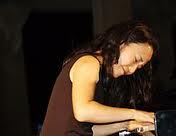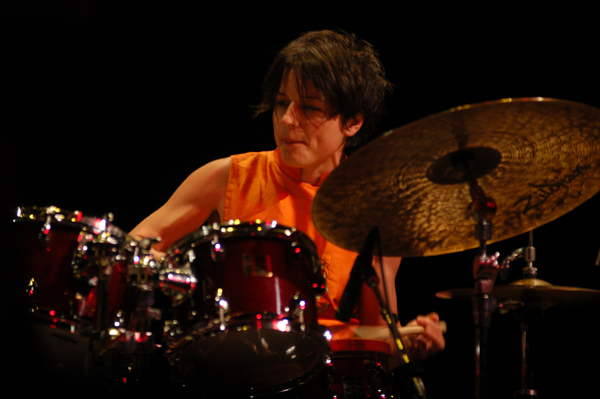One of the finest performances at last month’s Jazz Education Network Conference in Atlanta was turned in by a quartet led by the prolific and inquisitive violinist Christian Howes. It had been a minute since I’d seen Christian, a fellow Ohioan from one of my family towns, Columbus. The 40-year old Ohio State philosophy grad who spent nearly a decade living and playing around New York, has more recently been a dual resident of NYC and Columbus. He worked for eleven fruitful years with the late guitar pioneer Les Paul, and has spent time in the musical company of a wide range of artists from Greg Osby, D.D. Jackson, Jack DeJohnette and Dafnis Prieto to Richard Bona and Dave Samuels‘ Caribbean Jazz Project. In addition to giving a strong performance at JEN, Howes also presented a conference session for string players. After that sighting, and on the heels of his new record “Southern Exposure” (Resonance), a collaboration with accordionist Richard Galliano, coupled with being impressed at Howes’ maturity since first encountering him many years ago as an untamed violin force of nature, it seemed some questions were in order.

Talk about how your “Southern Exposure” collaboration with Richard Galliano came together.
George Klabin founded Resonance Records through a charitable foundation called “Rising Jazz Stars”. Part of his mission is to patronize emerging jazz artists. It’s really interesting when you consider that his record label is a not-for-profit company, and he’s doing it out of passion for the music. He has been involved in the creative aspects of all three recordings I’ve done on Resonance- everything from choosing songs, personnel, cover art, tracking, and mixing. He felt strongly about doing something with Richard Galliano, and I agreed that it would be a wonderful challenge to work on music drawing from Brazil, Spain, Argentina, and Cuba- sort of a “latin jazz”-inspired cd which, with the inclusion of Galliano, would push me to showcase different aspects of my playing, whether virtuosic-classical, romantic, or more modern-jazz. Richard is able to go to all those places, and he pushed me to try to reach his level of confidence and maturity- he has the ability to sound like himself in all these areas at that is inspiring to me.
Since I’m really drawn to what is happening “now” in jazz, including all the players in NYC really pushing the music forward, and admittedly I’m a bit self-conscious as a violinist in jazz, with “something to prove” and all that:), I wanted to make sure the playing on the record was relevant to what’s happening now, even while it’s obviously drawing on some “traditional” elements as well..If someone gives the album a cursory listen, they might be tempted to lump it into another french “salon”-style work, because of the violin-accordion pairing.. my hope is that people will go past that association and find something fresh and modern within the cd underneath the surface.
What was your process in terms of getting the proper feel, the best blend between violin and accordion – which is certainly an interesting sonic partnership.
It reminded me a bit of working with my friend Antonio Serrano, harmonica player, in Madrid, over a period of years, both because of the sort of expressive qualities and timbre of the instruments as well as certain similarities in the ways these two phrase and express themselves rhythmically. They have a real unashamed lyricism and still manage to come across with an underlying sense of blues, in their own way. Sometimes the “euro-gypsy” thing, to me, seems almost antithetical to the blues.. but in the case of these guys, I really feel they can go hand in hand.
To answer your question, as soon as I heard Richard in my headphones, I just felt a natural sense of being able to make music easily with him. He plays really musically, and he listens. It was just really easy to do the right things playing with him- like floating in a big soft cloud- really easy to blend and fall into his pocket or push and pull when I wanted.. The two instruments blend naturally as long as there’s music/listening going on.

At JEN you mentioned several off-bandstand projects you’ve been working on the last few years, please give us some details.
My online school, “The Creative Strings Academy”, at www.christianhowes.com is a subscription-based website with over 150 video lessons, ebooks, audio backing tracks, exercises, and more, focused in teaching classical musicians, especially bowed string players, to expand their musicianship and become “creative musicians”. I give them tools to improvise, compose, study other styles of music outside the classical realm, and help them with music business and technology questions as well.. I’ve had several hundred members and thousands of users engage with my curriculum. I offer regular webinars in real time as well and also offer Skype lessons and video paired feedback. The online learning has gone hand in hand with my initiative to visit school orchestra programs around the country in middle school, high school, and collegiate levels. Often I’ll do several workshops within a school district over a few days, culminating in a concert where the students all demonstrate what they’ve learned, improvising and sometimes even playing compositions we’ve created. This April my band is going to do one of these programs in a school district in Mcpherson, KS as part of Chamber Music America’s Residency Partnership grant.
I have another web 2.0 business which combines my unique musical skill set with the advent of file sharing. “Christian Howes Strings” is a service for producers and composers that provides “real” string sections at a fraction of the cost. The way it works: If you are producing a film score, commercial music, or album, you can simply send me a mix of your track. I send that mix around to my team of string players, each of whom has their own home studio. I work with violinists cellists, bassists, and violists scattered around different cities. Each of us will do several layers of string parts, put them together and send you all the individual wav files. So there may be 6 of us who play a total of 24 parts. This way, you get live strings on the scale of a real section, but you don’t have to pay 24 people, or a studio, and you don’t have to settle for sampled or synth strings. You can hear samples of our work and see our clients at www.christianhowes.com (click “production”)
Otherwise my projects off the bandstand include hanging with my wife, my 15-yr-old daughter and 3-yr-old son. Occasionally I play a little racquetball, watch movies, read books, or enjoy hiking and downhill skiing..
At JEN you gave a workshop titled “Improvisation for Classical String Players.” What did that presentation consist of and what’s the basic premise of your workshop?
The world of music, and music education, is separated by different “cultures of education” or ‘cultures of learning”. Classical musicians learn different things in different ways than musicians learning in other traditions like rock, jazz, blues, folk, etc… The classical musician’s skill set and knowledge base has deficits in three major areas. First, they are not generally encouraged to improvise or compose. Second, they do not generally have an awareness of the mechanical construction of the music they are playing (Jazz musicians understand the music they play, often, in the way a mechanic understands a car – he can take it apart and put it back together). FInally, classical musicians only play one “style” of music and are not typically exposed to other traditions outside the classical realm.
My goal as a teacher is to help them overcome these deficits by meeting them on their own terms. The “jazz studies” paradigm within music education does not meet classical musicians on their terms because it asks students to go straight into jazz harmony, jazz vocabulary, jazz history, and improvisation in a jazz context. Classical musicians often are not ready to make sense out of jazz. When I was 18 and I heard Miles and ‘Trane, it sounded like noise. It took years to enjoy the music and hear the beauty in it. That’s very common for classical musicians. I want to teach them to improvise, understand the mechanics of music, and open them to hearing new things. Later on they can find jazz if they want. in the meantime, let’s change the culture of education in the academic world of classical music education in general and bring all musical worlds closer together.
Are you finding an increasing number of string players have a desire to improvise?
String players, and classically trained musicians in general, are interested in improvisation. It’s got to change at the teaching level, and it is changing. The American String Teachers Association national conventions are PACKED with sessions given on improvisation and “eclectic styles” such as jazz, fiddle styles, rock, and other music outside the traditional classical repertoire. But there is still a huge lag in where they are as a whole, compared to the jazz community. And it’s very hard for them to assimilate into the jazz world. My annual summer camp for improvising string players is in it’s TENTH year, this July 1-5. We have players from all around the world who come to find a safe haven where they can work with rhythm sections and perform daily.
Why is the field of jazz playing, or improvising violinists still relatively small?
Assimilating into the jazz world as a string player and becoming accepted as “one of the cats”, requires a lot of commitment. You’ve got to want it really bad. FInding college programs or high school camps and jazz programs that will even accommodate a string player is still very hard. I inquired with Interlochen about my daughter participating in their summer jazz program, after explaining that she is an advanced jazz and classical violinist who has trained with a former Assoc. Professor at Berklee (me) since she was 3 years old, and their response was basically that they can’t accommodate a jazz violinist in their big band and combo program. How ridiculous is that!
But having said this, it’s really all about the education. String players learn their instruments from teachers who teach the classical way. If classical teachers are scared or ignorant, how can they instill creativity and other styles in their students? it’s changing though. I’m seeing a real shift and it will be more apparent in years to come. The issue is simply in training or education. There’s nothing inherent in the instrument that limits it’s ability to be a total vehicle of expression in jazz.
Christian Howes
www.christianhowes.com


























